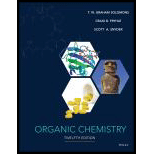
EBK ORGANIC CHEMISTRY
12th Edition
ISBN: 9781119233664
Author: Snyder
Publisher: VST
expand_more
expand_more
format_list_bulleted
Question
Chapter 1, Problem 8LGP
Interpretation Introduction
Interpretation:
The full-dash structural formula for the given compound is to be written.
Concept introduction:
In a dash structural formula, lines are drawn to show the bonding electrons. Single dash between two atoms represent two electrons, double dash between two atoms represent four atoms.
While writing this formula, symbols of all the elements present in a compound are shown.
In this, atoms are connected to each other by straight lines.
Expert Solution & Answer
Trending nowThis is a popular solution!

Students have asked these similar questions
how to get limiting reactant and %
yield based off this data
Compound
Mass 6) Volume(mL
Ben zaphone-5008
ne
Acetic Acid
1. Sam L
2-propanot
8.00
Benzopin-
a col
030445
Benzopin
a Colone 0.06743
Results
Compound
Melting Point (°c)
Benzopin
acol
172°c - 175.8 °c
Benzoping
to lone
1797-180.9
Assign ALL signals for the proton and carbon NMR spectra on the following pages.
7.5
1.93
2.05
C
B
A
4
3
5
The Joh.
9
7
8
1
2
7.5
7.0
6.5
6.0
5.5
5.0
4.5
4.0
3.5
3.0
2.5
2.0
1.5
1.0 ppm
9
7
8
0.86
OH 10
4
3
5
1
2
7.5
7.0
6.5
6.0
5.5
5.0
4.5
4.0
3.5
3.0
2.5
2.0
1.5
1.0
ppm
9
7
8
CI
4
3
5
1
2
7.0
6.5
6.0
5.5
5.0
4.5
4.0
3.5
3.0
2.5
2.0
2.21
4.00
1.5
2.00
2.07
1.0
ppm
2.76
Chapter 1 Solutions
EBK ORGANIC CHEMISTRY
Ch. 1 - Prob. 1PPCh. 1 - Prob. 2PPCh. 1 - Prob. 3PPCh. 1 - Prob. 4PPCh. 1 - Prob. 5PPCh. 1 - Prob. 6PPCh. 1 - Prob. 7PPCh. 1 - Prob. 8PPCh. 1 - Prob. 9PPCh. 1 - Prob. 10PP
Ch. 1 - Prob. 11PPCh. 1 - Prob. 12PPCh. 1 - Prob. 13PPCh. 1 - Prob. 14PPCh. 1 - Prob. 15PPCh. 1 - Prob. 16PPCh. 1 - Prob. 17PPCh. 1 - Prob. 18PPCh. 1 - Prob. 19PPCh. 1 - Prob. 20PPCh. 1 - Prob. 21PPCh. 1 - Practice Problem 1.22 Which of the following...Ch. 1 - Prob. 23PPCh. 1 - Prob. 24PPCh. 1 - Practice Problem 1.25
What do the bond angles of...Ch. 1 - Prob. 26PPCh. 1 - Practice Problem 1.27
Use VSEPR theory to predict...Ch. 1 - Practice Problem 1.28 Predict the bond angles of...Ch. 1 - 1.29 Which of the following ions possess the...Ch. 1 - 1.30 Write a Lewis structure for each of the...Ch. 1 - Prob. 31PCh. 1 - Add any unshared electrons to give each element an...Ch. 1 - Prob. 33PCh. 1 - What is the molecular formula for each of the...Ch. 1 - Prob. 35PCh. 1 - Prob. 36PCh. 1 - 1.37 Write bond-line formulas for all of the...Ch. 1 - Prob. 38PCh. 1 - Prob. 39PCh. 1 - Prob. 40PCh. 1 - Prob. 41PCh. 1 - (a) Cyanic acid (HOCN) and isocyanic acid (HN=C=O)...Ch. 1 - Consider a chemical species (either a molecule or...Ch. 1 - 1.44 Consider a chemical species like the one in...Ch. 1 - 1.45 Consider another chemical species like the...Ch. 1 - Draw a three-dimensional orbital representation...Ch. 1 - Ozone (O3) is found in the upper atmosphere where...Ch. 1 - Write resonance structures for the azide ion, N3....Ch. 1 - Write structural formulas of the type indicated:...Ch. 1 - Prob. 50PCh. 1 - 1.51 In Chapter 15 we shall learn how the...Ch. 1 - Prob. 52PCh. 1 - (a) Consider a carbon atom in its ground state....Ch. 1 - Open computer molecular models for dimethyl ether,...Ch. 1 - Boron is a group IIIA element. Open the molecular...Ch. 1 - 1.56 There are two contributing resonance...Ch. 1 - Prob. 1LGPCh. 1 - Consider the compound with the following condensed...Ch. 1 - Consider the compound with the following condensed...Ch. 1 - Consider the compound with the following condensed...Ch. 1 - Consider the compound with the following condensed...Ch. 1 - Consider the compound with the following condensed...Ch. 1 - Prob. 7LGPCh. 1 - Prob. 8LGP
Knowledge Booster
Similar questions
- Assign the functional group bands on the IR spectra.arrow_forwardFind the pH of a 0.120 M solution of HNO2. Find the pH ignoring activity effects (i.e., the normal way). Find the pH in a solution of 0.050 M NaCl, including activityarrow_forwardPlease help me answer these three questions. Required info should be in data table.arrow_forward
- Draw the major organic substitution product or products for (2R,3S)-2-bromo-3-methylpentane reacting with the given nucleophile. Clearly drawn the stereochemistry, including a wedged bond, a dashed bond and two in-plane bonds at each stereogenic center. Omit any byproducts. Bri CH3CH2O- (conc.) Draw the major organic product or products.arrow_forwardTartaric acid (C4H6O6) is a diprotic weak acid. A sample of 875 mg tartaric acid are dissolved in 100 mL water and titrated with 0.994 M NaOH. How many mL of NaOH are needed to reach the first equivalence point? How many mL of NaOH are needed to reach the second equivalence point?arrow_forwardIncluding activity, calculate the solubility of Pb(IO3)2 in a matrix of 0.020 M Mg(NO3)2.arrow_forward
- Order the following series of compounds from highest to lowest reactivity to electrophilic aromatic substitution, explaining your answer: 2-nitrophenol, p-Toluidine, N-(4-methylphenyl)acetamide, 4-methylbenzonitrile, 4-(trifluoromethyl)benzonitrile.arrow_forwardOrdene la siguiente serie de compuestos de mayor a menor reactividad a la sustitución aromática electrofílica, explicando su respuesta: ácido bencenosulfónico, fluorobenceno, etilbenceno, clorobenceno, terc-butilbenceno, acetofenona.arrow_forwardCan I please get all final concentrations please!arrow_forward
arrow_back_ios
SEE MORE QUESTIONS
arrow_forward_ios
Recommended textbooks for you
 ChemistryChemistryISBN:9781305957404Author:Steven S. Zumdahl, Susan A. Zumdahl, Donald J. DeCostePublisher:Cengage Learning
ChemistryChemistryISBN:9781305957404Author:Steven S. Zumdahl, Susan A. Zumdahl, Donald J. DeCostePublisher:Cengage Learning Chemistry: Principles and PracticeChemistryISBN:9780534420123Author:Daniel L. Reger, Scott R. Goode, David W. Ball, Edward MercerPublisher:Cengage Learning
Chemistry: Principles and PracticeChemistryISBN:9780534420123Author:Daniel L. Reger, Scott R. Goode, David W. Ball, Edward MercerPublisher:Cengage Learning

Chemistry
Chemistry
ISBN:9781305957404
Author:Steven S. Zumdahl, Susan A. Zumdahl, Donald J. DeCoste
Publisher:Cengage Learning

Chemistry: Principles and Practice
Chemistry
ISBN:9780534420123
Author:Daniel L. Reger, Scott R. Goode, David W. Ball, Edward Mercer
Publisher:Cengage Learning